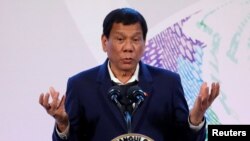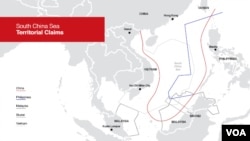Philippine President Rodrigo Duterte has placed a boundary on his fast-growing friendship with China by barring further Chinese activity off the Pacific coast and insisting that Beijing avoid new construction work in contested waters.
The president who changed Philippine foreign policy in 2016 by pursuing friendship with China, which has pledged loans, grants and investment in return, said Feb. 6 his country would no longer let foreign vessels explore the Philippine Rise, a potentially resource-rich underwater plateau off Luzon Island northeast of Manila. He had let China explore there the previous month and in late 2016.
A week later his spokesman said via the presidential office website that government officials “object and do not recognize the Chinese names” of five plateau features.
And on Friday the Philippine foreign minister said the two sides were discussing joint exploration in parts of the South China Sea that each side claims. China committed in that discussion not to “build on uninhabited features” as spelled out under a multicountry agreement reached in 2002, Manila’s foreign affairs department said Feb. 14.
These moves mark a reversal of Duterte’s earlier nods to Chinese use of seas claimed by the Philippines, said Antonio Contreras, political scientist at De La Salle University in the Philippines.
“Giving us all this aid and loans et cetera and then at the same time you are like keeping us behind, this is something that is not acceptable,” Contreras said.
Risk to the Philippines
Beijing claims about 90 percent of the South China Sea stretching from Hong Kong to Borneo. China lost a world court case, brought by the Philippines, in July 2016 over the legal basis for its sovereignty claim but has gone ahead with developments on numerous tiny islets. Both sides and four other governments prize the 3.5-million-square-kilometer waterway for fisheries and possible fossil fuel reserves. China does not claim the Philippine Rise.
The Philippines may be resisting China now to ensure a maximum return from the plateau, which is also believed to be rich in natural gas deposits, some scholars say.
The 13 million-hectare plateau, also known as Benham Rise, lies about 35 meters below the ocean surface on a continental shelf outside the South China Sea. In 2012 the United Nations Commission on the Limits of the Continental Shelf approved a Philippine claim to the plateau.
Duterte’s government should negotiate “clear and binding” terms with China to learn any results of joint exploration, said Fabrizio Bozzato, a Taiwan Strategy Research Association fellow specializing in East Asia.
“The Filipinos should find a way to have the Chinese sharing all the findings and data with them, because there’s a natural risk that the Chinese might decide to withhold some information, some vital information,” Bozzato said.
Beijing has taken control of disputed South China Sea islets first by sending low-profile research vessels and later coming in with landfill or military hardware, said Yun Sun, East Asia Program senior associate at the Stimson Center think tank in the United States.
Now, Sun said, “China acknowledges the rise to be on Philippine’s continental shelf, but insists on its rights to scientific research.”
Public suspicion
Common Filipinos are worried about getting too close with China, pressuring their head of state to use caution, said Ela Atienza, political science professor at University of the Philippines Diliman.
Months after taking office in June 2016, Duterte traveled to Beijing and received pledges of $24 billion in aid and investment from the larger economy. He has sidelined maritime sovereignty disputes since then.
Duterte’s public satisfaction rating was 79 percent in the fourth quarter of 2017, Metro Manila-based research institution Social Weather Stations found. Social Weather Stations polls indicate Filipinos are more likely to trust the United States, a former colonizer and military ally of seven decades, over China.
China unlikely to protest
China has made enough progress in waters claimed by the Philippines to temper any opposition to being banned now from the undersea plateau, to the rejection of Chinese names or to the commitment against further build-up in the South China Sea, some analysts believe.
“I suspect that they’re not going to be upset,” said Herman Kraft, another University of the Philippines Diliman political science professor. “This might be something that they understand. My suspicion is, that most of what they need, at least at this point in time, they’ve already got it.”
Easing any concern in Beijing, Duterte confirmed his broader friendship with China Monday in a speech to the Chinese Filipino Business Club in Manila.
“We can only be talking on friendly and civilized terms,” he said, as quoted by the presidential office website. “We cannot go there, ride in our whatever, navy, the gray ships, the coast guard and start waving our rifles. We cannot do that today. It is unrealistic. It cannot be true.”









